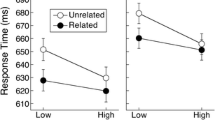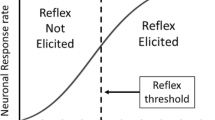Summary
Taniuchi, Sugihara, Wakashima, and Kamijo (2016) report the surprising finding that rats can transfer numerical discrimination to novel objects. Further experiments show that rat numerical discrimination is flexible, as it can both count homogeneous and heterogeneous objects and omit an odd object.
Similar content being viewed by others
Avoid common mistakes on your manuscript.
A popular procedure for the study of numerical discrimination in animals uses a row of objects, one of which contains a food reward. The object at a fixed ordinal number from one side of the row is always the correct one, and the question of interest is whether an animal can learn to reliably choose that object. In an article in Learning & Behavior, Taniuchi, Sugihara, Wakashima, and Kamijo (2016) looked for the property of abstraction. Humans use numbers to count virtually any number of objects. Is the ability of a rat to numerically discriminate number limited to the objects it is trained with, or can it transfer a numerical discrimination to novel objects? Rats responded to a row of 10 boxes, each of which contained a door that could be entered. From one trial to the next, four to six objects were placed in front of different sets of doors. Different types of objects were used throughout the experiments (e.g., glass bottles, metallic cans, ceramic dolls). Training began with presentation of a row of the same type of objects. As training proceeded, sets of new objects were introduced, always with accessible food behind only the third object. Next, periodic test trials were introduced on which a new set of objects was used to see if the rat would choose the third of these novel objects. Importantly, because the number of boxes used varied among test trials, and the spacing between boxes changed among trials, rats could not locate the correct box by its absolute position or by counting from the right side.
Two of the four rats used in Taniuchi et al.’s (2016) first experiment learned to choose the third box when three different objects were used on different trials. Of particular importance, these two rats scored above chance on probe test trials with a fourth set of novel objects. In order to test the possibility that the rats’ success was based on similarity perceived between the training and test objects, Taniuchi et al. used new objects in a second experiment. All three rats learned to choose the third object. When tested on probe trials with a set of novel objects, two of the three rats chose the third box above chance. In both Experiments 1 and 2, rats chose the third box on 60 %–80 % of the test trials. These results convincingly showed that rats did show abstraction by transferring numerical discrimination to a novel set of objects.
Having shown clear evidence for abstract numerical transfer, Taniuchi et al. (2016) report some truly remarkable findings from Experiments 3 and 4. The two successful rats from Experiment 2 continued to be tested in Experiment 3 with the four types of objects used in that experiment—call them A, B, C, and D. Although the rats had always been tested on homogeneous sets, such as AAAA, BBBB, CCCCC, or DDDDDD, they were now tested on probe trials that contained an odd item. Thus, they might encounter AABAA or CCCDCC. How would the rats handle this unusual array of objects, particularly arrays that contained the odd item as the third object in the row or as one of the objects before the third nonodd object? The results were clear and appeared immediately on testing. Rats excluded the odd item. If tested on AABAA, they chose the third A item above chance. This finding is quite important. It could have been argued from the initial transfer results of Experiments 1 and 2 that rats were simply discriminating number of objects without paying attention to the appearance of the objects. The findings of Experiment 3 suggest that rats had learned to “count” the number of wine glasses or the number of ceramic dolls and thus omitted any object without the appropriate features.
Given this specificity of numerical discrimination shown in Experiment 3, the findings of Experiment 4 are even more surprising. In this experiment, rats were given training trials with homogeneous sets of six different objects, AAAAAA, BBBBBB, CCCCCC, DDDDDD, EEEEEE, or FFFFFF. On other trials, however, they encountered sets of objects with no repeating objects, such as EACBFD or BDEAFC. Although one might expect the rats to be confused by such arrays, they continued to respond to the third object at levels above chance. The combined findings of Experiments 3 and 4 suggest that rats showed what the authors call categorical flexibility—that is, rats could adjust their numerical strategy to the array they encountered on each particular trial. If the majority of objects were the same, then they “counted” just those objects. If the array was heterogeneous, however, they then resorted to “counting” each object regardless of its appearance.
How did they do it? Two facts about these experiments are important. First, it took many trials over many sessions for the rats to perform well on this task. Counting even to three is not easy for a rat. Second, counting is not precise. Even after many sessions of training, rats still make errors. Interestingly, Taniuchi et al. (2016) found that these errors were usually at locations near the correct location.
It seems clear from these observations that rats are not counting in the way adult humans count. That is, they are not assigning discrete cardinal number symbols to objects in a fixed order. A human performing this task would rarely make an error; rather, the process used by rats has been described as use of an “approximate number system.” Such a system frequently yields the correct number but also has error built into it. The errors that occur follow interesting patterns that give us clues as to how animals represent approximate number. Two well-known effects are the distance effect and the size effect. When an animal is required to discriminate between two numbers of objects, its ability to detect a difference improves as the distance between the numbers increases. When the difference between two numbers is held constant, however, the difficulty of the discrimination increases as the size of the numbers increases. Thus, it is more difficult to discriminate 8 from 10 than it is to discriminate 2 from 4. Many will recognize the size effect as Weber’s law, the principle that increases in a magnitude must be larger to detect a difference as the magnitude’s sensation increases.
Application of Weber’s law to numerical discrimination also gives rise to an effect called scalar variability. Had Taniuchi et al. (2016) further tested their rats at higher numbers of objects, say five or seven objects, scalar variability predicts that an increasing dispersion of errors would be found as the number of objects increased. In fact, this phenomenon has been found in a number of experiments studying numerical discrimination in animals and preverbal children. The phenomena of the distance effect, the size effect, ratio discrimination, and scalar variability, all of which follow from Weber’s law, provide clues for a cognitive model of numerical discrimination in animals. One model suggests that each successive object in a series adds a quantity to a continuous number line (Dehaene, 2008). Because representations of number along this line become more and more compact at higher numbers, the representation of number is logarithmic.
Where is number represented? Accumulating evidence suggests that it may be represented in the intraparietal sulcus (IPS) in the posterior parietal lobe of the primate brain. Studies have found activation of neurons in the IPS in both monkeys and humans when numbers of objects are shown to a subject either successively or simultaneously (Cantlon, Brannon, Carter, & Pelphrey, 2006; Nieder, Diester, & Tudusciuc, 2006). It has been suggested that accumulator neurons earlier in the visual system then activate number neurons in the IPS (Dehaene, 2008).
Although studies of numerical representation in the rat brain have yet to be carried out, we might suspect that neural coding similar to that in the primate brain will be found. What do studies like that reported by Taniuchi et al. (2016) suggest about these brain processes? First, they seem to suggest that a large number of trials must occur for the activation of number neurons to further activate response systems that give rise to a correct choice. Although number neurons may be found in the rat brain, these new findings raise important questions about how activation of these neurons controls choice. Apparently, other neural systems have hierarchical control over which objects are counted. For example, when an odd item appears among otherwise identical objects, how is neural response to the odd item excluded? Does this exclusion occur at an early perceptual or accumulator stage or at a later stage, where number neurons are activated? Perhaps an inhibitory circuit damps response to the odd object. If so, how does this inhibition of response to the odd object get turned off when all the items are different from one another? Eventual studies that examine neural activity in the rat brain when discriminating number in homogeneous, odd-item, and heterogeneous sets of objects should reveal how the rat brain allows it to make these complex numerical distinctions.
References
Cantlon, J. F., Brannon, E. M., Carter, E. J., & Pelphrey, K. A. (2006). Functional imaging of numerical processing in adults and 4-y-old children. PLoS Biology, 4, 1–11.
Dehaene, S. (2008). Symbols and quantities in parietal cortex: Elements of a mathematical theory or number representation and manipulation. In P. Haggard, Y. Rossetti, & M. Kawato (Eds.), Sensorimotor foundations of higher cognition (attention & performance) (pp. 527–574). Oxford, UK: Oxford University Press.
Nieder, A., Diester, I., & Tudusciuc, O. (2006). Temporal and spatial enumeration processes in the primate parietal cortex. Science, 313, 1431–1435.
Taniuchi, T., Sugihara, J., Wakashima, M., & Kamijo, M. (2016). Abstract numerical discrimination learning in rats. Learning & Behavior. doi:10.3758/s13420-016-0209-2
Author information
Authors and Affiliations
Corresponding author
Rights and permissions
About this article
Cite this article
Roberts, W.A. Rats respond where it counts. Learn Behav 44, 101–102 (2016). https://doi.org/10.3758/s13420-016-0229-y
Published:
Issue Date:
DOI: https://doi.org/10.3758/s13420-016-0229-y




